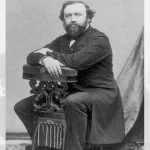
The Bizarre Tale of the Boy From Nowhere
Brent Swancer February 25, 2022
Just as mysterious as anyone who has ever vanished off the face of the earth without a trace are those enigmatic individuals who have seemingly appeared from nowhere. These are those mysterious people who seem to have just shown up with no known identity or history, and often with cryptic clues surrounding them, as if they have just stepped into our reality from some other dimension or timeline. Often these people go their whole lives without anyone ever truly knowing who they really are, waling, living puzzles that will never be solved. In the 19th century one such person crawled out of the ether to materialize in Germany, and would spark a deep mystery that has been discussed and debated to this day.
One such case from history which has gained quite a lot of recognition is that of a mysterious young man who would come to be known as Kaspar Hauser. The setting of this account is Nuremberg, Germany, where on 26 May 1828 a young man in his teens who no one recognized suddenly appeared wandering the streets. The seemingly bewildered, confused boy was found to be carrying in his trembling hand a letter addressed to a Captain von Wessenig, who was the captain of the 4th squadron of the 6th cavalry regiment. The unknown author of the letter stated that the boy was attained as an infant, taken in, educated at home, and had never left the confines of the house. The letter ended with the statement that the boy wished to be a cavalryman, that his father had been a cavalryman, and Wessenig was given the ultimatum to either “take him in or to hang him.” Another short letter was found that seemed to be from the mother, who called the boy Kaspar and claimed that his true father had been a cavalryman who had died for reasons unspecified. Oddly, both letters seemed to be written in the exact same handwriting.
Questions posed to the boy and indeed all attempts to communicate with him proved to be frustratingly futile, as the only thing he would say was “I want to be a cavalryman, as my father was” or “Horse!” repeated over and over again. When pressed on anything, he would simply say “Don’t know.” He refused to eat or drink anything except bread and water. He also showed only the most remedial awareness of common everyday rituals such as using money or basic grooming and social skills, and he was only able to read to a very limited degree. The only useful information he seemed to be able to provide was his full name in a childish scrawl on a piece of paper; Kaspar Hauser. Other than that, no one had any idea of who he really was or where he had come from. He was a total enigma.
 The first theory as to Kaspar’s origins was that he was some sort of feral child raised among animals out in the wilderness, which would explain his lack of social awareness and limited communication skills. However, as Kaspar began to gain the ability to more fully express himself more light began to be shed upon his mysterious background. He described how he had essentially been raised in a dungeon; a tiny darkened cell not even large enough to stand in, in which he had lived totally alone and slept on a straw bed. His meals were claimed to have been bread and water left for him each morning. He claimed that not once in all of his years growing up did he ever meet his mysterious caretaker, or even another human being for that matter. The boy had never learned to talk or even walk, and had lived his whole life hunched over in that cramped, dank cell with only a few small wooden toys to keep him company. It was not until right before he was released that he had met another person for the first time, who he claimed was a man who did not show his face and had taught him to write his name, stand, and walk. The enigmatic stranger also had apparently taught Kaspar his first words by phonetic repetition and rote memory, “I want to be a cavalryman, as my father was,” the actual meaning of which he could not comprehend at the time.
The first theory as to Kaspar’s origins was that he was some sort of feral child raised among animals out in the wilderness, which would explain his lack of social awareness and limited communication skills. However, as Kaspar began to gain the ability to more fully express himself more light began to be shed upon his mysterious background. He described how he had essentially been raised in a dungeon; a tiny darkened cell not even large enough to stand in, in which he had lived totally alone and slept on a straw bed. His meals were claimed to have been bread and water left for him each morning. He claimed that not once in all of his years growing up did he ever meet his mysterious caretaker, or even another human being for that matter. The boy had never learned to talk or even walk, and had lived his whole life hunched over in that cramped, dank cell with only a few small wooden toys to keep him company. It was not until right before he was released that he had met another person for the first time, who he claimed was a man who did not show his face and had taught him to write his name, stand, and walk. The enigmatic stranger also had apparently taught Kaspar his first words by phonetic repetition and rote memory, “I want to be a cavalryman, as my father was,” the actual meaning of which he could not comprehend at the time.
Such a strange yet undeniably intriguing story soon circulated among the media, and before long Kaspar Hauser was big news all over the world, with people everywhere wondering just who he was. At the time, theories were already swirling, claiming that he was everything from royalty to a flat out liar. In the meantime, Kaspar was taken into the care of a schoolmaster and philosopher by the name of Friedrich Daumer, who further educated him in a wide variety of subjects. Over time, Kaspar adjusted to his new life, but no one was any closer to understanding his murky origins. Indeed, a series of bizarre occurrences would only serve to deepen the mystery surrounding him.
On 17 October 1829, Kaspar was found in the cellar with a cut on his forehead after he had failed to show up for his usual lunch. The visibly shaken boy claimed that he had been attacked by a man in a hood, who had sounded exactly like the man who had brought him to Nuremburg and who had threatened him before cutting him with a knife and fleeing. Kaspar then claimed that he had escaped down into the cellar to hide, leaving a trail of blood along the floor as he did so. In the wake of the mysterious attack, Kaspar was moved into the care of a municipal authority by the name of Johann Biberbach for his own safety. It was never found out for certain just who had attacked him, or indeed whether he had merely inflicted the wound on himself. The move would not stop the strange string of events unfolding. After Kapsar had settled into Biberbach’s house, yet another odd incident would occur, when on 3 April 1830 there was a sudden gunshot that rang out from his room. Kaspar was found to be bleeding from a gash on the side of his head, and when pressed on what had happened he claimed that he had been climbing up on a chair to reach some books and had accidentally knocked down a gun hanging on the wall, which had then gone off. Oddly, the cut on his head did not seem have been consistent with a gunshot wound. Kaspar was moved yet again, this time to the house of his next patron, a landowner named Baron von Tucher.
During this time, there were beginning weird rumors that Kaspar was a rather unpleasant, abrasive person to be around. In fact, both Biberbach and von Tucher openly complained that the boy was disagreeable, a habitual liar, and extremely vain, with an exasperated Biberbach once stating that Kaspar was skilled in the “art of dissimulation” and “full of vanity and spite.” Claims such as these started to eat away at the boy’s credibility, and there was increasing speculation that he had faked the knife attack and gunshot perhaps in order to manipulate others into feeling sorry for him. Further evidence of deception would come when a British nobleman named Lord Stanhope took him into custody and spent immense resources trying to investigate Kaspar’s past based on his accounts, but had come up completely empty-handed, leading him to doubt that the boy was telling the whole truth. Yet another caretaker of Kaspar’s named Johann Georg Meyer quickly parted ways with the boy after a strained relationship full of arguments and lies, and he would later proclaim “I had been deceived.” Yet another caretaker by the name of Anselm von Feuerbach would later say of Kaspar “Caspar Hauser is a smart scheming codger, a rogue, a good-for-nothing that ought to be killed.” Not exactly words of praise.
 With doubt cast on the veracity of his story, and his credibility unravelling even as speculation boiled on where he had come from or even who he was Kaspar would meet an end that was every bit as mysterious as his life had been. On 14 December 1833, Hauser came home with a deep wound in his chest, and claimed that he had been attacked by a knife-wielding man in Ansbach Court Garden. An investigation would turn up a purse lying in the garden which contained a cryptic note scrawled on a piece of paper which was written in mirror writing in German and rife with grammatical mistakes. The mysterious note read:
With doubt cast on the veracity of his story, and his credibility unravelling even as speculation boiled on where he had come from or even who he was Kaspar would meet an end that was every bit as mysterious as his life had been. On 14 December 1833, Hauser came home with a deep wound in his chest, and claimed that he had been attacked by a knife-wielding man in Ansbach Court Garden. An investigation would turn up a purse lying in the garden which contained a cryptic note scrawled on a piece of paper which was written in mirror writing in German and rife with grammatical mistakes. The mysterious note read:
Hauser will be able to tell you quite precisely how I look and from where I am. To save Hauser the effort, I want to tell you myself from where I come _ _ . I come from from _ _ _the Bavarian border _ _On the river _ _ _ _ _I will even tell you the name: M. L. Ö.
It has never been conclusively determined what the message means, who wrote the note, or what role they had to play in Kasper’s fate, if any. Kaspar Hauser would die of the grievous knife wound on 17 December 1833; his death as every bit as weird and mysterious as his life had been, leaving behind the strange note and far more questions than he had ever been able to answer. The headstone of his grave, located in the city cemetery of Ansbach, is testament to his enigmatic origins and life, reading “Here lies Kaspar Hauser, riddle of his time. His birth was unknown, his death mysterious. 1833.” Indeed, the mystery and speculation surrounding the life and death of Kaspar Hauser has shown little sign of waning in the subsequent years, and he has spawned numerous theories about who he could have been and who was responsible for his death.
One popular theory at the time was that Kaspar was in fact the hereditary prince of Baden, and the prince had been switched with another baby before mysteriously appearing 16 years later in Nuremburg as Kaspar Hauser. In this scenario, Kaspar was imprisoned by the Countess of Hochberg so that her sons could be successors to the title in the absence of any surviving male progeny of Charles, Grand Duke of Baden, and indeed it was for this reason that he was surmised to have been ultimately murdered. While this theory has often been thrown about, there is very little evidence to show that this was the case and it has largely been dismissed by historians.
 In light of many of the inconsistencies and oddities of Kaspar’s story, there are others who believe that the whole thing was more or less a big scam carried out by Kaspar himself, or that it was merely a tall tale woven by a possibly mentally impaired teenager. There are several issues that cast doubt on Kaspar’s own version of events. One is that when he was found he did not seem to exhibit any of the health issues that one would expect of someone who had lived their whole life in a cramped, subterranean dungeon as claimed. For instance, such a long, uninterrupted period of time in absolute darkness should have most certainly resulted in rickets, yet the records show that Kaspar had no such condition, and in fact he was described as being rather healthy looking with a vibrant complexion. He was also in good physical condition for someone who claimed that they had been unable to stand their whole life and had just learned to walk, and Kaspar was able to run or climb stairs with no particular difficulty. It seems that anyone who had lived under such harsh conditions for their entire life would likely have been paler, sicklier, less physically fit, and indeed far more mentally impaired than Kaspar seemed to be. It has also been pointed out that the letters he had been carrying when he was originally found bore handwriting that was uncannily similar to his own. For these reasons, it is thought that the whole account of his previous life had been a fanciful fiction, that Kaspar was a pathological liar, and that the attacks he had suffered were also lies, with the wounds self-inflicted.
In light of many of the inconsistencies and oddities of Kaspar’s story, there are others who believe that the whole thing was more or less a big scam carried out by Kaspar himself, or that it was merely a tall tale woven by a possibly mentally impaired teenager. There are several issues that cast doubt on Kaspar’s own version of events. One is that when he was found he did not seem to exhibit any of the health issues that one would expect of someone who had lived their whole life in a cramped, subterranean dungeon as claimed. For instance, such a long, uninterrupted period of time in absolute darkness should have most certainly resulted in rickets, yet the records show that Kaspar had no such condition, and in fact he was described as being rather healthy looking with a vibrant complexion. He was also in good physical condition for someone who claimed that they had been unable to stand their whole life and had just learned to walk, and Kaspar was able to run or climb stairs with no particular difficulty. It seems that anyone who had lived under such harsh conditions for their entire life would likely have been paler, sicklier, less physically fit, and indeed far more mentally impaired than Kaspar seemed to be. It has also been pointed out that the letters he had been carrying when he was originally found bore handwriting that was uncannily similar to his own. For these reasons, it is thought that the whole account of his previous life had been a fanciful fiction, that Kaspar was a pathological liar, and that the attacks he had suffered were also lies, with the wounds self-inflicted.
Indeed, in this theory the very knife wound that killed him may have been from Kaspar himself, and he had simply cut himself more deeply than he had intended. Other clues surrounding his death point to this possibility as well. For instance, the handwriting and grammatical mistakes of the note found in the garden from the alleged attacker were similar to Kaspar’s, and the letter had been folded in the same characteristic way that he folded other letters he had written. However, for all of the speculation and theories, to this day no one really knows for sure who Kaspar Hauser was, where he came from, how much of his story was true, or who really killed him and the case continues to be a baffling enigma that puzzles right up to the present, and which may never have a definitive answer.
MU*






















